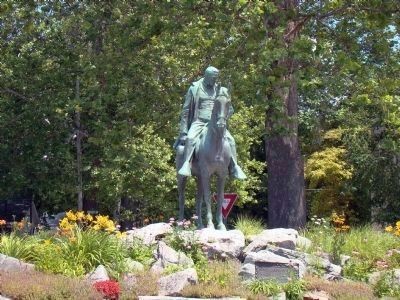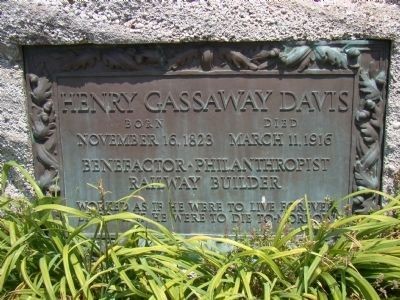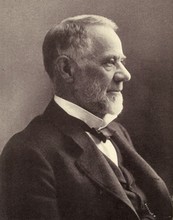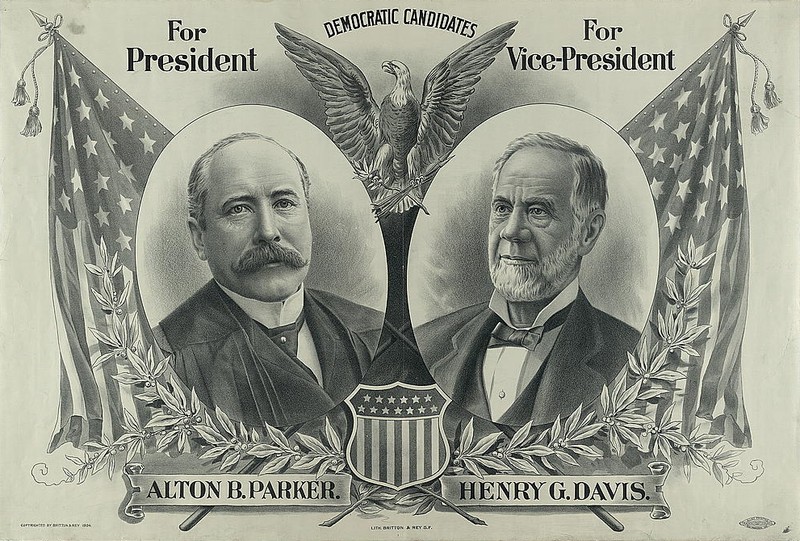Henry Gassaway Davis Statue (Elkins)
Introduction
Text-to-speech Audio
Images
This statue of Henry Gassaway Davis was dedicated in 1927.

Henry Gassaway Davis marker. "Worked as if he were to live forever. Lives as if he were to die to-morrow."

Henry Gassaway Davis

1904 Parker/Davis Democratic presidential candidate poster

Backstory and Context
Text-to-speech Audio
Henry Gassaway Davis was born in Baltimore, Maryland in 1823. Although forced to leave school to obtain work before finishing elementary school, Davis would become a leading supporter of higher education. After working as a farmhand, Davis secured a position with the Baltimore and Ohio Railroad as a brakeman. From this humble beginning in 1842, he slowly worked his way through the organization, first by becoming a conductor, and later being promoted to station agent. Thanks to his wife's inherited land in what would eventually become the town of Elkins, and his capacity to live within his means, Davis was able to invest his earnings in real estate. Though his efforts, Elkins became a booming railroad town by 1890.
"When he was on the railroad as a brakeman, he spent many, many cold hours riding on the top of a coal pile on a coal car. He probably escaped death just by a whisker many, many times over. That was life out on the railroad. Who better to represent a state like West Virginia than someone who has come from the bottom, made his fortunes, knows what West Virginia is all about?" - Historian, John Hankey1
Davis left the B&O railroad in 1858 to pursue a career in the coal and timber industries. Davis and his brother recognized that these resources would be the key to industrial development in Appalachia long before the timber and coal booms of the the late 19th and early 20th century, Davis also found himself in position to provide resources to the Union army as the the nation went to war in 1861.
As his business interests grew, Davis turned to politics, where he focused on issues related to the development of the railroad. As he gained political influence, he was able to exert some control over the location of railroads which allowed him to support the economic interests of his constituents while also supporting his interests in the coal and timber industries. Davis was elected to the House of Delegates in 1865 and then the West Virginia Senate in 1868. After helping the Democratic Party take hold, Davis became the first West Virginian Democratic U.S. senator in 1871 and served until 1883. Throughout this period, Davis joined other white Southern Democrats in opposing Republican efforts to reconstruct the South and promote political rights for former slaves.2
After his voluntary retirement from the Senate, Davis again focused on the railroad. Through his efforts and influence, the West Virginia Central and Pittsburgh was extended through Tucker, Barbour and Pocahontas Counties until he had connected his road with the Baltimore and Ohio on the western side of the mountains, and also with the Chesapeake and Ohio. This development led to founding of Elkins.
Davis soon returned to politics, becoming the Democratic Party's vice presidential candidate alongside Alton B. Parker in 1904. Parker chose Davis primarily on Davis' wealth, connections, and ability to secure funds for the campaign. However, the two Democrats lost to Republican candidates Theodore Roosevelt and Charles Fairbanks.
The statue sits adjacent to the entrance of Davis and Elkins College, and was placed there in 1927. Davis died in Washington, D.C. on March 11, 1916 at the age of 92 following a short illness. He is buried in Maplewood Cemetery in Elkins. The statue commemorates West Virginia’s ‘‘Grand Old Man,’’ best remembered as a politician and business leader who dedicated his life to promoting industrial development in West Virginia via railroads, timber, and coal.
Sources
1. West Virginia memory project - film transcripts. Retrieved September 6, 2016, from http://www.wvculture.org/history/wvmemory/filmtranscripts/wv.html 2. Share Henry Gassaway Davis. (2016). Retrieved September 7, 2016, from http://www.wvencyclopedia.org/articles/1711 3.Henry Gassaway Davis historical marker. (2006). Retrieved September 6, 2016, from http://www.hmdb.org/marker.asp?marker=9371
